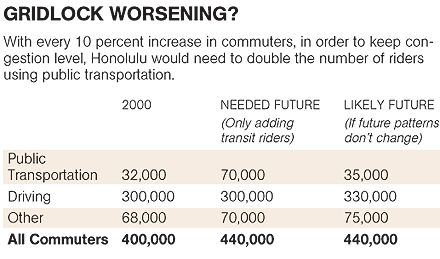Honolulu Advertiser
SECOND OPINION by Cliff Slater
June 13, 2005
Transit: What
is happening elsewhere?
N
Yes, our elected officials go to other cities and kick the
tires, so to speak. However, they do not then undertake the lab
Texas Transp
“To accomplish a goal of
maintaining a constant congestion level in these areas by only adding transit
riders [would require] expanding transit systems by m
That’s a 250 percent increase
every three years and clearly, this is not happening here,[ii] the mainland,[iii]
Here’s what they are talking about.
On the other hand, if we set ourselves the goal of keeping level
the number of those commuting by automobile, then we have to double the
percentage of people public transp

What is the likelihood of that happening?
If you examine the U.S. Department of Transp
This is why from 1990 to 2000, despite federal, state and
local operating subsidies[vi]
and capital outlays[vii] f
Are there any answers?
Given the reality that we are not getting out of our cars — no
matter what — and given our inability to fund expansion of our regular highway
system sufficiently, then we have to turn to some f
Honolulu’s best initial move could be High Occupancy Toll
lanes,
If anyone knows of any other method that has reduced traffic
congestion in practice (and just not in the
Cliff Slater is a
regular columnist whose footnoted columns are at: www.lava.net/cslater
[iv]
Christian Gerondeau. “Mass
Transit: A Tale of Two Cities' Transportation”
[viii] Federal Highway Administration’s file, msacomparison_orig.xls
|
|
2000 |
|
Needed Future |
% |
Likely future |
% |
|
Public Transp |
32,000 |
8% |
70,000 |
16% |
35,000 |
8% |
|
Driving |
300,000 |
75% |
300,000 |
68% |
330,000 |
75% |
|
Other |
68,000 |
17% |
70,000 |
16% |
75,000 |
17% |
|
All Commuters |
400,000 |
100% |
440,000 |
100% |
440,000 |
100% |